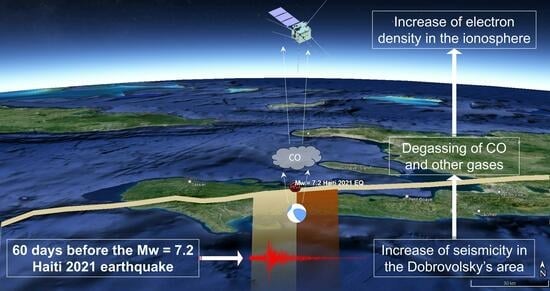Observation of the Preparation Phase Associated with Mw = 7.2 Haiti Earthquake on 14 August 2021 from a Geophysical Data Point of View
Abstract
:1. Introduction
2. Materials and Methods
2.1. Data and Methods for Lithosphere
2.2. Data and Methods for Atmosphere
2.3. Data and Methods for the Ionosphere
2.3.1. CSES-01, Ne
2.3.2. Swarm, Magnetic Field
2.3.3. TEC
3. Results
3.1. Lithosphere
3.2. Atmosphere
3.3. Ionosphere
4. Discussion
- Tropical Storm ANA from 22 to 23 May 2021. This storm affected the North-Center Atlantic Ocean, which is very far from the investigated area.
- Tropical Storm BILL from 14 to 15 June 2021. This storm was generated in the North Atlantic Ocean and arrived close to the Northern coast of Florida, which is still far from the investigated area, affecting the results of this work.
- Tropical Storm CLAUDETTE from 19 to 22 June 2021. This storm was generated in the North Atlantic Ocean, close to the Nova Scotia (Canada) coast, travelled inside the USA and ended in the Gulf of Mexico. Despite passing around the investigated area, it was completely outside the Dobrovoslkys’s area.
- Tropical Storm DANNY from 27 to 29 June 2021. This storm was generated in the Central Atlantic Ocean and arrived at the coast border between Florida and Georgia States. It was far from the investigated area.
- Hurricane ELSA from 30 June to 9 July 2021. This hurricane passed in the investigated area, which is further discussed below.
- Tropical Storm FRED from 11 to 17 August 2021. This storm passed inside the investigated area, which is further discussed below.
- Hurricane GRACE from 13 to 21 August 2021. This hurricane crossed the investigated area, but mainly after the Haiti 2021 earthquake.
- High seismicity in the Dobrovolsky area 171 days before the mainshock.
- Increased ionospheric anomalies from 88 to 77 days before the mainshock. This group of anomalies is detected mainly by the Swarm magnetic field, but CSES-01 Ne also depicted some anomalies. It is the most abundant increase in ionospheric anomalies before the Mw = 7.2 Haiti 2021 earthquake, but it is not preceded by significant anomalies in the lithosphere or ionosphere, so its link with the incoming earthquake is uncertain.
- Increased seismic rate from about 80 to 60 days before the mainshock, synchronous with anomalies in the atmosphere and two consecutive days of CSES-01 Ne anomalies. This is a possible complete coupling between the lithosphere–atmosphere and ionosphere. It is still possible to describe it with the Pulinets and Ouzounov LAIC model, as in addition to carbon monoxide release, there are also aerosol anomalies and higher concentrations of surface SO2, which may also be released due to the stress increase. The first atmospheric anomalous parameter in this time range (−80 days) was methane, which could have acted as a gas carrier to bring radioactive substances into the atmosphere, inducing ionisation, as proposed by Etiope and Martinelli [104]. This may lead to an increase of Ne recorded by CSES-01, as simulated by Kuo [105]. This is also somehow compatible with the LAIC theory of Pulinets and Ouzonouv [90], despite the lack of evidence (such as missing OLR, humidity drop, etc.) to confirm this explanation. This may be due to particular local conditions or observation limitations, especially for ground instrumentation.
5. Conclusions
Supplementary Materials
Funding
Data Availability Statement
Acknowledgments
Conflicts of Interest
Appendix A. Analysis of Methane Data Version 6 of AIRS
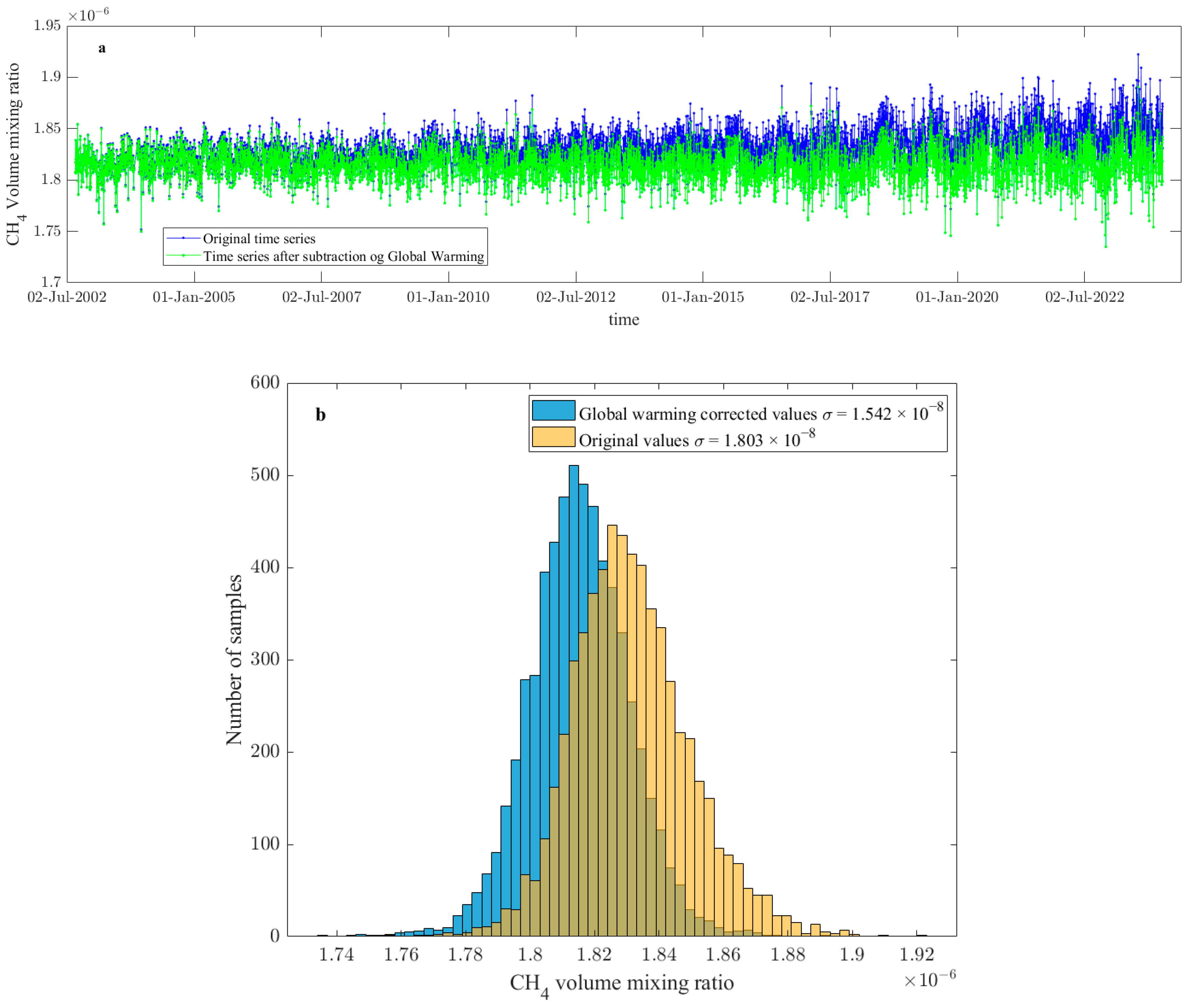

Appendix B. CSES-01 Ne Daytime Analysis
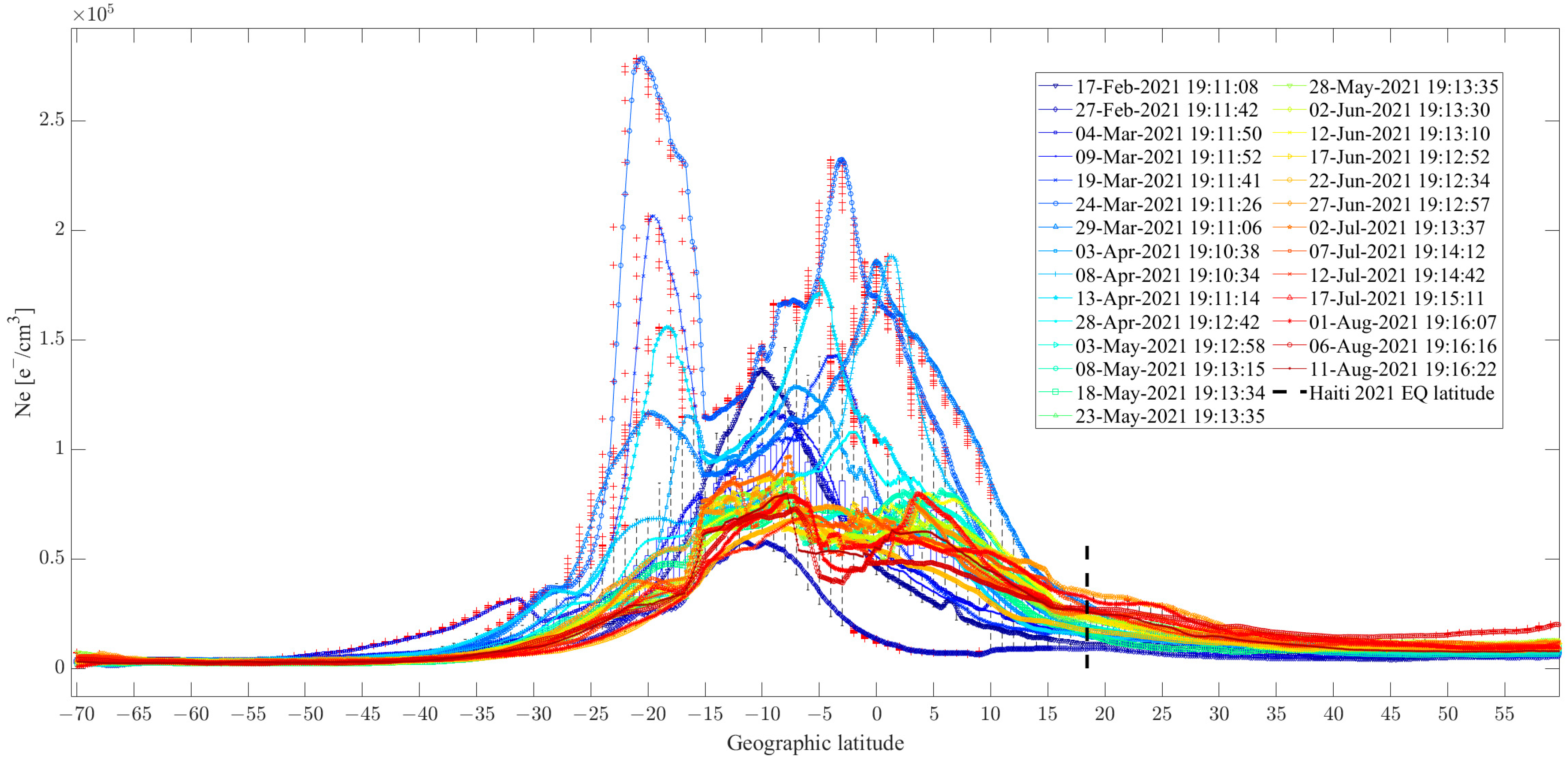
Appendix C. Magnitude of Completeness of Earthquake Catalogue
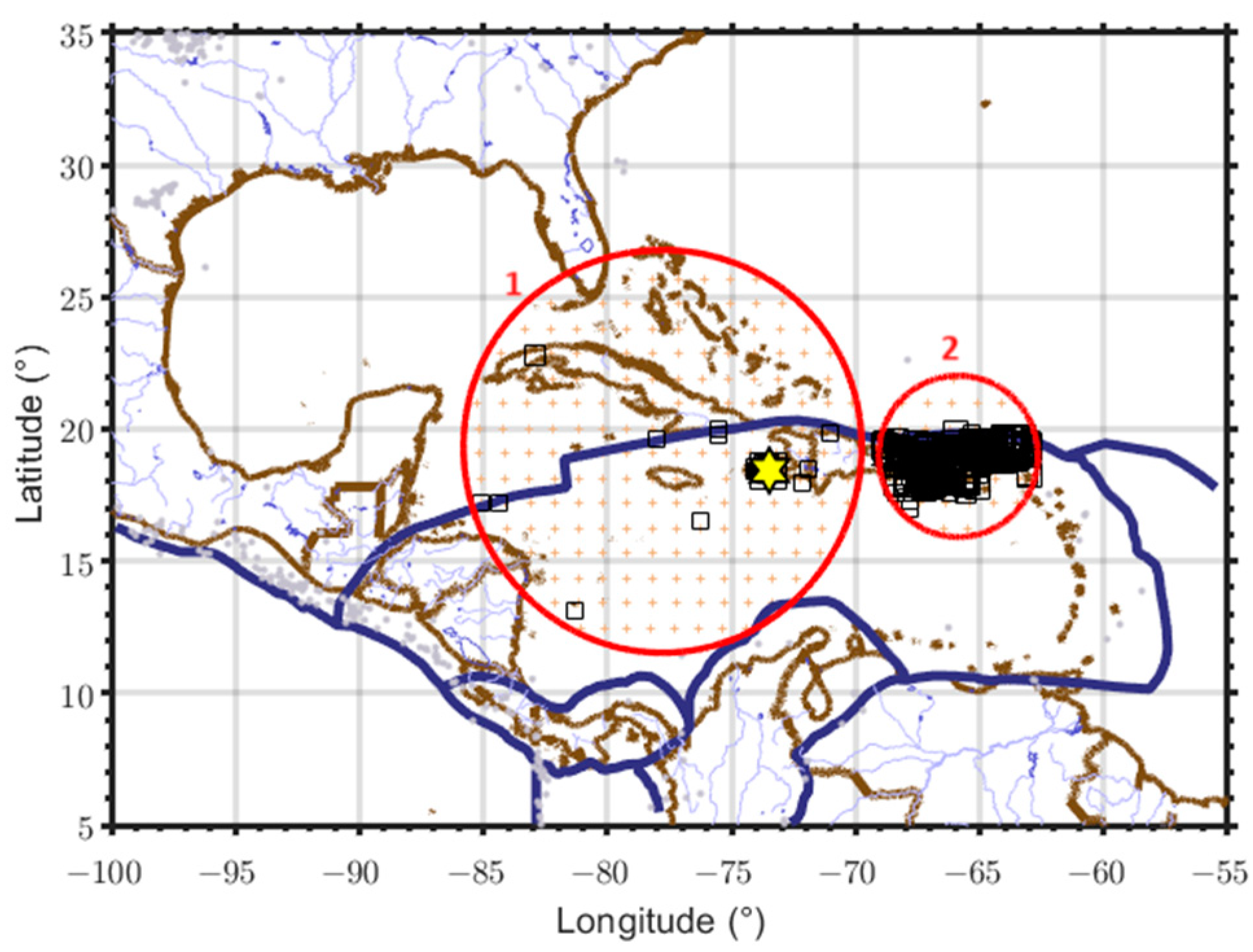

References
- Ze, Z.; Guojie, M.; Xiaoning, S.; Jicang, W.; Xiaojing, L.J. Global Crustal Movement and Tectonic Plate Boundary Deformation Constrained by the ITRF2008. Geod. Geodyn. 2012, 3, 40–45. [Google Scholar] [CrossRef]
- Geller, R.J. Earthquake Prediction: A Critical Review. Geophys. J. Int. 1997, 131, 425–450. [Google Scholar] [CrossRef]
- Conti, L.; Picozza, P.; Sotgiu, A. A Critical Review of Ground Based Observations of Earthquake Precursors. Front. Earth Sci. 2021, 9, 676766. [Google Scholar] [CrossRef]
- Picozza, P.; Conti, L.; Sotgiu, A. Looking for Earthquake Precursors From Space: A Critical Review. Front. Earth Sci. 2021, 9, 676775. [Google Scholar] [CrossRef]
- Fidani, C.; Freund, F.; Grant, R. Cows Come Down from the Mountains before the (Mw = 6.1) Earthquake Colfiorito in September 1997; A Single Case Study. Animals 2014, 4, 292–312. [Google Scholar] [CrossRef] [PubMed]
- Shen, X.; Zong, Q.-G.; Zhang, X. Introduction to Special Section on the China Seismo-Electromagnetic Satellite and Initial Results. Earth Planet. Phys. 2018, 2, 439–443. [Google Scholar] [CrossRef]
- Ghamry, E.; Marchetti, D.; Yoshikawa, A.; Uozumi, T.; De Santis, A.; Perrone, L.; Shen, X.; Fathy, A. The First Pi2 Pulsation Observed by China Seismo-Electromagnetic Satellite. Remote Sens. 2020, 12, 2300. [Google Scholar] [CrossRef]
- Yang, Y.; Hulot, G.; Vigneron, P.; Shen, X.; Zhima, Z.; Zhou, B.; Magnes, W.; Olsen, N.; Tøffner-Clausen, L.; Huang, J.; et al. The CSES Global Geomagnetic Field Model (CGGM): An IGRF-Type Global Geomagnetic Field Model Based on Data from the China Seismo-Electromagnetic Satellite. Earth Planets Space 2021, 73, 45. [Google Scholar] [CrossRef]
- Yang, Y.-Y.; Zhima, Z.-R.; Shen, X.-H.; Chu, W.; Huang, J.-P.; Wang, Q.; Yan, R.; Xu, S.; Lu, H.-X.; Liu, D.-P. The First Intense Geomagnetic Storm Event Recorded by the China Seismo-Electromagnetic Satellite. Space Weather 2020, 18, e2019SW002243. [Google Scholar] [CrossRef]
- Yan, R.; Zhima, Z.; Xiong, C.; Shen, X.; Huang, J.; Guan, Y.; Zhu, X.; Liu, C. Comparison of Electron Density and Temperature From the CSES Satellite With Other Space-Borne and Ground-Based Observations. J. Geophys. Res. Space Phys. 2020, 125, e2019JA027747. [Google Scholar] [CrossRef]
- Zhou, B.; Cheng, B.; Gou, X.; Li, L.; Zhang, Y.; Wang, J.; Magnes, W.; Lammegger, R.; Pollinger, A.; Ellmeier, M.; et al. First In-Orbit Results of the Vector Magnetic Field Measurement of the High Precision Magnetometer Onboard the China Seismo-Electromagnetic Satellite. Earth Planets Space 2019, 71, 119. [Google Scholar] [CrossRef]
- Gou, X.; Li, L.; Zhou, B.; Zhang, Y.; Xie, L.; Cheng, B.; Feng, Y.; Wang, J.; Miao, Y.; Zhima, Z.; et al. Electrostatic Ion Cyclotron Waves Observed by CSES in the Equatorial Plasma Bubble. Geophys. Res. Lett. 2023, 50, e2022GL101791. [Google Scholar] [CrossRef]
- Mignan, A. The Stress Accumulation Model: Accelerating Moment Release and Seismic Hazard. In Advances in Geophysics; Elsevier: Amsterdam, The Netherlands, 2008; Volume 49, pp. 67–201. ISBN 978-0-12-374231-5. [Google Scholar]
- De Santis, A.; Cianchini, G.; Di Giovambattista, R. Accelerating Moment Release Revisited: Examples of Application to Italian Seismic Sequences. Tectonophysics 2015, 639, 82–98. [Google Scholar] [CrossRef]
- Kato, A.; Fukuda, J.; Kumazawa, T.; Nakagawa, S. Accelerated Nucleation of the 2014 Iquique, Chile Mw 8.2 Earthquake. Sci. Rep. 2016, 6, 24792. [Google Scholar] [CrossRef] [PubMed]
- Filizzola, C.; Corrado, A.; Genzano, N.; Lisi, M.; Pergola, N.; Colonna, R.; Tramutoli, V. RST Analysis of Anomalous TIR Sequences in Relation with Earthquakes Occurred in Turkey in the Period 2004–2015. Remote Sens. 2022, 14, 381. [Google Scholar] [CrossRef]
- Tramutoli, V.; Cuomo, V.; Filizzola, C.; Pergola, N.; Pietrapertosa, C. Assessing the Potential of Thermal Infrared Satellite Surveys for Monitoring Seismically Active Areas: The Case of Kocaeli (İzmit) Earthquake, August 17, 1999. Remote Sens. Environ. 2005, 96, 409–426. [Google Scholar] [CrossRef]
- Tramutoli, V.; Bello, G.D.; Pergola, N.; Piscitelli, S. Robust Satellite Techniques for Remote Sensing of Seismically Active Areas. Ann. Geophys. 2001, 44, 295–312. [Google Scholar] [CrossRef]
- Genzano, N.; Filizzola, C.; Hattori, K.; Pergola, N.; Tramutoli, V. Statistical Correlation Analysis Between Thermal Infrared Anomalies Observed From MTSATs and Large Earthquakes Occurred in Japan (2005–2015). J. Geophys. Res. Solid Earth 2021, 126, e2020JB020108. [Google Scholar] [CrossRef]
- Jing, F.; Singh, R.P. Changes in Tropospheric Ozone Associated With Strong Earthquakes and Possible Mechanism. IEEE J. Sel. Top. Appl. Earth Obs. Remote Sens. 2021, 14, 5300–5310. [Google Scholar] [CrossRef]
- Tronin, A.A. Remote Sensing and Earthquakes: A Review. Phys. Chem. Earth Parts A/B/C 2006, 31, 138–142. [Google Scholar] [CrossRef]
- Molchanov, O.A.; Hayakawa, M.; Rafalsky, V.A. Penetration Characteristics of Electromagnetic Emissions from an Underground Seismic Source into the Atmosphere, Ionosphere, and Magnetosphere. J. Geophys. Res. 1995, 100, 1691. [Google Scholar] [CrossRef]
- Han, P.; Hattori, K.; Hirokawa, M.; Zhuang, J.; Chen, C.-H.; Febriani, F.; Yamaguchi, H.; Yoshino, C.; Liu, J.-Y.; Yoshida, S. Statistical Analysis of ULF Seismomagnetic Phenomena at Kakioka, Japan, during 2001–2010: Ulf Seismo-Magnetic Phenomena at Kakioka. J. Geophys. Res. Space Phys. 2014, 119, 4998–5011. [Google Scholar] [CrossRef]
- Cianchini, G.; De Santis, A.; Barraclough, D.R.; Wu, L.X.; Qin, K. Magnetic Transfer Function Entropy and the 2009 Mw = 6.3 L’Aquila Earthquake (Central Italy). Nonlin. Process. Geophys. 2012, 19, 401–409. [Google Scholar] [CrossRef]
- Fidani, C.; Orsini, M.; Iezzi, G.; Vicentini, N.; Stoppa, F. Electric and Magnetic Recordings by Chieti CIEN Station During the Intense 2016–2017 Seismic Swarms in Central Italy. Front. Earth Sci. 2020, 8, 536332. [Google Scholar] [CrossRef]
- Fraser-Smith, A.C.; Bernardi, A.; McGill, P.R.; Ladd, M.E.; Helliwell, R.A.; Villard, O.G. Low-Frequency Magnetic Field Measurements near the Epicenter of the Ms 7.1 Loma Prieta Earthquake. Geophys. Res. Lett. 1990, 17, 1465–1468. [Google Scholar] [CrossRef]
- Uyeda, S.; Hayakawa, M.; Nagao, T.; Molchanov, O.; Hattori, K.; Orihara, Y.; Gotoh, K.; Akinaga, Y.; Tanaka, H. Electric and Magnetic Phenomena Observed before the Volcano-Seismic Activity in 2000 in the Izu Island Region, Japan. Proc. Natl. Acad. Sci. USA 2002, 99, 7352–7355. [Google Scholar] [CrossRef] [PubMed]
- De Santis, A.; Balasis, G.; Pavón-Carrasco, F.J.; Cianchini, G.; Mandea, M. Potential Earthquake Precursory Pattern from Space: The 2015 Nepal Event as Seen by Magnetic Swarm Satellites. Earth Planet. Sci. Lett. 2017, 461, 119–126. [Google Scholar] [CrossRef]
- Christodoulou, V.; Bi, Y.; Wilkie, G. A Tool for Swarm Satellite Data Analysis and Anomaly Detection. PLoS ONE 2019, 14, e0212098. [Google Scholar] [CrossRef] [PubMed]
- Xie, T.; Chen, B.; Wu, L.; Dai, W.; Kuang, C.; Miao, Z. Detecting Seismo-Ionospheric Anomalies Possibly Associated With the 2019 Ridgecrest (California) Earthquakes by GNSS, CSES, and Swarm Observations. JGR Space Phys. 2021, 126, e2020JA028761. [Google Scholar] [CrossRef]
- Athanasiou, M.A.; Anagnostopoulos, G.C.; Iliopoulos, A.C.; Pavlos, G.P.; David, C.N. Enhanced ULF Radiation Observed by DEMETER Two Months around the Strong 2010 Haiti Earthquake. Nat. Hazards Earth Syst. Sci. 2011, 11, 1091–1098. [Google Scholar] [CrossRef]
- Ouyang, X.Y.; Parrot, M.; Bortnik, J. ULF Wave Activity Observed in the Nighttime Ionosphere Above and Some Hours Before Strong Earthquakes. J. Geophys. Res. Space Phys. 2020, 125, e2020JA028396. [Google Scholar] [CrossRef]
- Chen, H.; Han, P.; Hattori, K. Recent Advances and Challenges in the Seismo-Electromagnetic Study: A Brief Review. Remote Sens. 2022, 14, 5893. [Google Scholar] [CrossRef]
- Hayakawa, M. Seismo Electromagnetics and Earthquake Prediction: History and New Directions. IJEAR 2019, 6, 1–23. [Google Scholar] [CrossRef]
- Hayakawa, M.; Schekotov, A.; Izutsu, J.; Nickolaenko, A.P.; Hobara, Y. Seismogenic ULF/ELF Wave Phenomena: Recent Advances and Future Perspectives. Open J. Earthq. Res. 2023, 12, 45–113. [Google Scholar] [CrossRef]
- Ghamry, E.; Mohamed, E.K.; Abdalzaher, M.S.; Elwekeil, M.; Marchetti, D.; De Santis, A.; Hegy, M.; Yoshikawa, A.; Fathy, A. Integrating Pre-Earthquake Signatures From Different Precursor Tools. IEEE Access 2021, 9, 33268–33283. [Google Scholar] [CrossRef]
- De Santis, A.; Marchetti, D.; Pavón-Carrasco, F.J.; Cianchini, G.; Perrone, L.; Abbattista, C.; Alfonsi, L.; Amoruso, L.; Campuzano, S.A.; Carbone, M.; et al. Precursory Worldwide Signatures of Earthquake Occurrences on Swarm Satellite Data. Sci. Rep. 2019, 9, 20287. [Google Scholar] [CrossRef]
- Marchetti, D.; De Santis, A.; Campuzano, S.A.; Zhu, K.; Soldani, M.; D’Arcangelo, S.; Orlando, M.; Wang, T.; Cianchini, G.; Di Mauro, D.; et al. Worldwide Statistical Correlation of Eight Years of Swarm Satellite Data with M5.5+ Earthquakes: New Hints about the Preseismic Phenomena from Space. Remote Sens. 2022, 14, 2649. [Google Scholar] [CrossRef]
- He, Y.; Zhao, X.; Yang, D.; Wu, Y.; Li, Q. A Study to Investigate the Relationship between Ionospheric Disturbance and Seismic Activity Based on Swarm Satellite Data. Phys. Earth Planet. Inter. 2022, 323, 106826. [Google Scholar] [CrossRef]
- Zhima, Z.; Yan, R.; Lin, J.; Wang, Q.; Yang, Y.; Lv, F.; Huang, J.; Cui, J.; Liu, Q.; Zhao, S.; et al. The Possible Seismo-Ionospheric Perturbations Recorded by the China-Seismo-Electromagnetic Satellite. Remote Sens. 2022, 14, 905. [Google Scholar] [CrossRef]
- Chen, W.; Marchetti, D.; Zhu, K.; Sabbagh, D.; Yan, R.; Zhima, Z.; Shen, X.; Cheng, Y.; Fan, M.; Wang, S.; et al. CSES-01 Electron Density Background Characterisation and Preliminary Investigation of Possible Ne Increase before Global Seismicity. Atmosphere 2023, 14, 1527. [Google Scholar] [CrossRef]
- Perevalova, N.P.; Sankov, V.A.; Astafyeva, E.I.; Zhupityaeva, А.S. Threshold Magnitude for Ionospheric TEC Response to Earthquakes. J. Atmos. Sol. Terr. Phys. 2014, 108, 77–90. [Google Scholar] [CrossRef]
- Cicerone, R.D.; Ebel, J.E.; Britton, J. A Systematic Compilation of Earthquake Precursors. Tectonophysics 2009, 476, 371–396. [Google Scholar] [CrossRef]
- Lin, J.-W.; Chiou, J.-S. Detecting Total Electron Content Precursors Before Earthquakes by Examining Total Electron Content Images Based on Butterworth Filter in Convolutional Neural Networks. IEEE Access 2020, 8, 110478–110494. [Google Scholar] [CrossRef]
- Liu, J.; Wang, W.; Zhang, X.; Wang, Z.; Zhou, C. Ionospheric Total Electron Content Anomaly Possibly Associated with the April 4, 2010 Mw7.2 Baja California Earthquake. Adv. Space Res. 2022, 69, 2126–2141. [Google Scholar] [CrossRef]
- Perrone, L.; Korsunova, L.P.; Mikhailov, A.V. Ionospheric Precursors for Crustal Earthquakes in Italy. Ann. Geophys. 2010, 28, 941–950. [Google Scholar] [CrossRef]
- Sabbagh, D.; Orlando, M.; Perrone, L.; Cianchini, G.; De Santis, A.; Piscini, A. Analysis of the Ionospheric Perturbations Prior to the 2009 L’Aquila and 2002 Molise Earthquakes from Ground- and Space-Based Observations. URSI Radio Sci. Lett. 2021, 3, 1–4. [Google Scholar] [CrossRef]
- Korsunova, L.P.; Khegai, V.V. Medium-Term Ionospheric Precursors to Strong Earthquakes. Int. J. Geomagn. Aeron. 2006, 6, GI3005. [Google Scholar] [CrossRef]
- Kumar, A.; Kumar, S.; Hayakawa, M.; Menk, F. Subionospheric VLF Perturbations Observed at Low Latitude Associated with Earthquake from Indonesia Region. J. Atmos. Sol. Terr. Phys. 2013, 102, 71–80. [Google Scholar] [CrossRef]
- Hayakawa, M.; Kasahara, Y.; Nakamura, T.; Muto, F.; Horie, T.; Maekawa, S.; Hobara, Y.; Rozhnoi, A.A.; Solovieva, M.; Molchanov, O.A. A Statistical Study on the Correlation between Lower Ionospheric Perturbations as Seen by Subionospheric VLF/LF Propagation and Earthquakes: Seismo-ionospheric perturbations. J. Geophys. Res. 2010, 115, A09305. [Google Scholar] [CrossRef]
- Politis, D.Z.; Potirakis, S.M.; Contoyiannis, Y.F.; Biswas, S.; Sasmal, S.; Hayakawa, M. Statistical and Criticality Analysis of the Lower Ionosphere Prior to the 30 October 2020 Samos (Greece) Earthquake (M6.9), Based on VLF Electromagnetic Propagation Data as Recorded by a New VLF/LF Receiver Installed in Athens (Greece). Entropy 2021, 23, 676. [Google Scholar] [CrossRef]
- Styron, R.; García-Pelaez, J.; Pagani, M. GEM Central America and Caribbean Active Faults Database. 2018. Available online: https://github.com/GEMScienceTools/central_am_carib_faults (accessed on 9 February 2024).
- Styron, R.; García-Pelaez, J.; Pagani, M. CCAF-DB: The Caribbean and Central American Active Fault Database. Nat. Hazards Earth Syst. Sci. 2020, 20, 831–857. [Google Scholar] [CrossRef]
- Burbach, G.V.; Frohlich, C.; Pennington, W.D.; Matumoto, T. Seismicity and Tectonics of the Subducted Cocos Plate. J. Geophys. Res. Solid Earth 1984, 89, 7719–7735. [Google Scholar] [CrossRef]
- Cordani, U.; Ramos, V.; Fraga, L.; Cegarra, M.; Delgado, I.; de Souza, K.G.; Gomes, F.E.; Schobbenhaus, C. Tectonic Map of South America at 1:5,900,000 Scale, 600th ed.; Commission for the Geological Map of the World (CGMW): Paris, France, 2019. [Google Scholar]
- Cediel, F.; Shaw, R.P.; Cáceres, C. Tectonic Assembly of the Northern Andean Block. In The Circum-Gulf of Mexico and the Caribbean: Hydrocarbon Habitats, Basin Formation and Plate Tectonics; Bartolini, C., Buffler, R.T., Blickwede, J.F., Eds.; American Association of Petroleum Geologists: Tulsa, OK, USA, 2003; Volume 79, ISBN 978-1-62981-054-6. [Google Scholar]
- Akhoondzadeh, M. Investigation of the LAIC Mechanism of the Haiti Earthquake (14 August 2021) Using CSES-01 Satellite Observations and Other Earthquake Precursors. Adv. Space Res. 2024, 73, 672–684. [Google Scholar] [CrossRef]
- Akhoondzadeh, M.; Marchetti, D. Study of the Preparation Phase of Turkey’s Powerful Earthquake (6 February 2023) by a Geophysical Multi-Parametric Fuzzy Inference System. Remote Sens. 2023, 15, 2224. [Google Scholar] [CrossRef]
- Khan, M.M.; Ghaffar, B.; Shahzad, R.; Khan, M.R.; Shah, M.; Amin, A.H.; Eldin, S.M.; Naqvi, N.A.; Ali, R. Atmospheric Anomalies Associated with the 2021 Mw 7.2 Haiti Earthquake Using Machine Learning from Multiple Satellites. Sustainability 2022, 14, 14782. [Google Scholar] [CrossRef]
- Chen, D.; Meng, D.; Wang, F.; Gou, Y. A Study of Ionospheric Anomaly Detection before the August 14, 2021 Mw7.2 Earthquake in Haiti Based on Sliding Interquartile Range Method. Acta Geodaetica et Geophysica 2023, 58, 539–551. [Google Scholar] [CrossRef]
- D’Angelo, G.; Piersanti, M.; Battiston, R.; Bertello, I.; Carbone, V.; Cicone, A.; Diego, P.; Papini, E.; Parmentier, A.; Picozza, P.; et al. Haiti Earthquake (Mw 7.2): Magnetospheric–Ionospheric–Lithospheric Coupling during and after the Main Shock on 14 August 2021. Remote Sens. 2022, 14, 5340. [Google Scholar] [CrossRef]
- Rapoport, Y.G.; Gotynyan, O.E.; Ivchenko, V.M.; Kozak, L.V.; Parrot, M. Effect of Acoustic-Gravity Wave of the Lithospheric Origin on the Ionospheric F Region before Earthquakes. Phys. Chem. Earth Parts A/B/C 2004, 29, 607–616. [Google Scholar] [CrossRef]
- Godin, O.A. Finite-Amplitude Acoustic-Gravity Waves: Exact Solutions. J. Fluid Mech. 2015, 767, 52–64. [Google Scholar] [CrossRef]
- Yeh, K.C.; Liu, C.H. Acoustic-Gravity Waves in the Upper Atmosphere. Rev. Geophys. 1974, 12, 193. [Google Scholar] [CrossRef]
- Yang, S.-S.; Hayakawa, M. Gravity Wave Activity in the Stratosphere before the 2011 Tohoku Earthquake as the Mechanism of Lithosphere-Atmosphere-Ionosphere Coupling. Entropy 2020, 22, 110. [Google Scholar] [CrossRef] [PubMed]
- Yang, S.; Asano, T.; Hayakawa, M. Abnormal Gravity Wave Activity in the Stratosphere Prior to the 2016 Kumamoto Earthquakes. JGR Space Phys. 2019, 124, 1410–1425. [Google Scholar] [CrossRef]
- Kundu, S.; Chowdhury, S.; Ghosh, S.; Sasmal, S.; Politis, D.Z.; Potirakis, S.M.; Yang, S.-S.; Chakrabarti, S.K.; Hayakawa, M. Seismogenic Anomalies in Atmospheric Gravity Waves as Observed from SABER/TIMED Satellite during Large Earthquakes. J. Sens. 2022, 2022, 1–23. [Google Scholar] [CrossRef]
- Hayakawa, M.; Kasahara, Y.; Nakamura, T.; Hobara, Y.; Rozhnoi, A.; Solovieva, M.; Molchanov, O.; Korepanov, V. Atmospheric Gravity Waves as a Possible Candidate for Seismo-Ionospheric Perturbations. J. Atmos. Electr. 2011, 31, 129–140. [Google Scholar] [CrossRef]
- Zhang, Y.; Wang, T.; Chen, W.; Zhu, K.; Marchetti, D.; Cheng, Y.; Fan, M.; Wang, S.; Wen, J.; Zhang, D.; et al. Are There One or More Geophysical Coupling Mechanisms before Earthquakes? The Case Study of Lushan (China) 2013. Remote Sens. 2023, 15, 1521. [Google Scholar] [CrossRef]
- Akhoondzadeh, M.; De Santis, A.; Marchetti, D.; Piscini, A.; Cianchini, G. Multi Precursors Analysis Associated with the Powerful Ecuador (MW = 7.8) Earthquake of 16 April 2016 Using Swarm Satellites Data in Conjunction with Other Multi-Platform Satellite and Ground Data. Adv. Space Res. 2018, 61, 248–263. [Google Scholar] [CrossRef]
- Marchetti, D.; De Santis, A.; D’Arcangelo, S.; Poggio, F.; Piscini, A.; Campuzano, S.A.; De Carvalho, W.V.J.O. Pre-Earthquake Chain Processes Detected from Ground to Satellite Altitude in Preparation of the 2016–2017 Seismic Sequence in Central Italy. Remote Sens. Environ. 2019, 229, 93–99. [Google Scholar] [CrossRef]
- Marchetti, D.; De Santis, A.; Shen, X.; Campuzano, S.A.; Perrone, L.; Piscini, A.; Di Giovambattista, R.; Jin, S.; Ippolito, A.; Cianchini, G.; et al. Possible Lithosphere-Atmosphere-Ionosphere Coupling Effects Prior to the 2018 Mw = 7.5 Indonesia Earthquake from Seismic, Atmospheric and Ionospheric Data. J. Asian Earth Sci. 2020, 188, 104097. [Google Scholar] [CrossRef]
- De Santis, A.; Perrone, L.; Calcara, M.; Campuzano, S.A.; Cianchini, G.; D’Arcangelo, S.; Di Mauro, D.; Marchetti, D.; Nardi, A.; Orlando, M.; et al. A Comprehensive Multiparametric and Multilayer Approach to Study the Preparation Phase of Large Earthquakes from Ground to Space: The Case Study of the June 15 2019, M7.2 Kermadec Islands (New Zealand) Earthquake. Remote Sens. Environ. 2022, 283, 113325. [Google Scholar] [CrossRef]
- Marchetti, D.; Zhu, K.; Marchetti, L.; Zhang, Y.; Chen, W.; Cheng, Y.; Fan, M.; Wang, S.; Wang, T.; Wen, J.; et al. Quick Report on the ML = 3.3 on 1 January 2023 Guidonia (Rome, Italy) Earthquake: Evidence of a Seismic Acceleration. Remote Sens. 2023, 15, 942. [Google Scholar] [CrossRef]
- Rikitake, T. Classification of Earthquake Precursors. Tectonophysics 1979, 54, 293–309. [Google Scholar] [CrossRef]
- Rikitake, T. Earthquake Precursors in Japan: Precursor Time and Detectability. Tectonophysics 1987, 136, 265–282. [Google Scholar] [CrossRef]
- Scholz, C.H.; Sykes, L.R.; Aggarwal, Y.P. Earthquake Prediction: A Physical Basis. Science 1973, 181, 803–810. [Google Scholar] [CrossRef] [PubMed]
- Scholz, C.H. Earthquakes and Friction Laws. Nature 1998, 391, 37–42. [Google Scholar] [CrossRef]
- Console, R.; Yamaoka, K.; Zhuang, J. Implementation of Short- and Medium-Term Earthquake Forecasts. Int. J. Geophys. 2012, 2012, 1–2. [Google Scholar] [CrossRef]
- Dobrovolsky, I.P.; Zubkov, S.I.; Miachkin, V.I. Estimation of the Size of Earthquake Preparation Zones. Pageoph 1979, 117, 1025–1044. [Google Scholar] [CrossRef]
- Wiemer, S. A Software Package to Analyze Seismicity: ZMAP. Seismol. Res. Lett. 2001, 72, 373–382. [Google Scholar] [CrossRef]
- Gelaro, R.; McCarty, W.; Suárez, M.J.; Todling, R.; Molod, A.; Takacs, L.; Randles, C.A.; Darmenov, A.; Bosilovich, M.G.; Reichle, R.; et al. The Modern-Era Retrospective Analysis for Research and Applications, Version 2 (MERRA-2). J. Climate 2017, 30, 5419–5454. [Google Scholar] [CrossRef] [PubMed]
- De Santis, A.; Cianchini, G.; Marchetti, D.; Piscini, A.; Sabbagh, D.; Perrone, L.; Campuzano, S.A.; Inan, S. A Multiparametric Approach to Study the Preparation Phase of the 2019 M7.1 Ridgecrest (California, United States) Earthquake. Front. Earth Sci. 2020, 8, 540398. [Google Scholar] [CrossRef]
- Marchetti, D.; Zhu, K.; Zhang, H.; Zhima, Z.; Yan, R.; Shen, X.; Chen, W.; Cheng, Y.; He, X.; Wang, T.; et al. Clues of Lithosphere, Atmosphere and Ionosphere Variations Possibly Related to the Preparation of La Palma 19 September 2021 Volcano Eruption. Remote Sens. 2022, 14, 5001. [Google Scholar] [CrossRef]
- Akhoondzadeh, M.; De Santis, A.; Marchetti, D.; Shen, X. Swarm-TEC Satellite Measurements as a Potential Earthquake Precursor Together With Other Swarm and CSES Data: The Case of Mw7.6 2019 Papua New Guinea Seismic Event. Front. Earth Sci. 2022, 10, 820189. [Google Scholar] [CrossRef]
- Marchetti, D.; De Santis, A.; Campuzano, S.A.; Soldani, M.; Piscini, A.; Sabbagh, D.; Cianchini, G.; Perrone, L.; Orlando, M. Swarm Satellite Magnetic Field Data Analysis Prior to 2019 Mw = 7.1 Ridgecrest (California, USA) Earthquake. Geosciences 2020, 10, 502. [Google Scholar] [CrossRef]
- Jakowski, N.; Béniguel, Y.; De Franceschi, G.; Pajares, M.H.; Jacobsen, K.S.; Stanislawska, I.; Tomasik, L.; Warnant, R.; Wautelet, G. Monitoring, Tracking and Forecasting Ionospheric Perturbations Using GNSS Techniques. J. Space Weather Space Clim. 2012, 2, A22. [Google Scholar] [CrossRef]
- Badeke, R.; Borries, C.; Hoque, M.M.; Minkwitz, D. Empirical Forecast of Quiet Time Ionospheric Total Electron Content Maps over Europe. Adv. Space Res. 2018, 61, 2881–2890. [Google Scholar] [CrossRef]
- Hattori, K.; Serita, A.; Gotoh, K.; Yoshino, C.; Harada, M.; Isezaki, N.; Hayakawa, M. ULF Geomagnetic Anomaly Associated with 2000 Izu Islands Earthquake Swarm, Japan. Phys. Chem. Earth Parts A/B/C 2004, 29, 425–435. [Google Scholar] [CrossRef]
- Pulinets, S.; Ouzounov, D. Lithosphere–Atmosphere–Ionosphere Coupling (LAIC) Model–An Unified Concept for Earthquake Precursors Validation. J. Asian Earth Sci. 2011, 41, 371–382. [Google Scholar] [CrossRef]
- Pulinets, S.; Ouzounov, D.; Karelin, A.; Boyarchuk, K. Near-Ground Processes as a Result of Air Ionization. In Earthquake Precursors in the Atmosphere and Ionosphere: New Concepts; Pulinets, S., Ouzounov, D., Karelin, A., Boyarchuk, K., Eds.; Springer: Dordrecht, The Netherlands, 2022; pp. 1–60. ISBN 978-94-024-2172-9. [Google Scholar]
- Piscini, A.; De Santis, A.; Marchetti, D.; Cianchini, G. A Multi-Parametric Climatological Approach to Study the 2016 Amatrice–Norcia (Central Italy) Earthquake Preparatory Phase. Pure Appl. Geophys. 2017, 174, 3673–3688. [Google Scholar] [CrossRef]
- Liu, S.; Cui, Y.; Wei, L.; Liu, W.; Ji, M. Pre-Earthquake MBT Anomalies in the Central and Eastern Qinghai-Tibet Plateau and Their Association to Earthquakes. Remote Sens. Environ. 2023, 298, 113815. [Google Scholar] [CrossRef]
- Freund, F. Pre-Earthquake Signals: Underlying Physical Processes. J. Asian Earth Sci. 2011, 41, 383–400. [Google Scholar] [CrossRef]
- Freund, F.; Ouillon, G.; Scoville, J.; Sornette, D. Earthquake Precursors in the Light of Peroxy Defects Theory: Critical Review of Systematic Observations. Eur. Phys. J. Spec. Top. 2021, 230, 7–46. [Google Scholar] [CrossRef]
- Politis, D.Z.; Potirakis, S.M.; Kundu, S.; Chowdhury, S.; Sasmal, S.; Hayakawa, M. Critical Dynamics in Stratospheric Potential Energy Variations Prior to Significant (M > 6.7) Earthquakes. Symmetry 2022, 14, 1939. [Google Scholar] [CrossRef]
- John, P.C.; Sandy, D.; Robbie, B. Hurricane Elsa; National Hurricane Center Tropical Cyclone Report; National Hurricane Center: Miami, FA, USA, 2022. [Google Scholar]
- Robbie, B. Tropical Storm Fred; National Hurricane Center Tropical Cyclone Report; National Hurricane Center: Miami, FA, USA, 2021. [Google Scholar]
- Brad, J.R.; Amanda, R.; Robbie, B. Hurricane Grace; National Hurricane Center Tropical Cyclone Report; National Hurricane Center: Miami, FA, USA, 2022. [Google Scholar]
- Alfaro, S.; Sen-Crowe, B.; Autrey, C.; Elkbuli, A. Trends in Carbon Monoxide Poisoning Deaths in High Frequency Hurricane States from 2014–19: The Need for Prevention Intervention Strategies. J. Public Health 2023, 45, e250–e259. [Google Scholar] [CrossRef] [PubMed]
- Subramanian, R.; Ellis, A.; Torres-Delgado, E.; Tanzer, R.; Malings, C.; Rivera, F.; Morales, M.; Baumgardner, D.; Presto, A.; Mayol-Bracero, O.L. Air Quality in Puerto Rico in the Aftermath of Hurricane Maria: A Case Study on the Use of Lower Cost Air Quality Monitors. ACS Earth Space Chem. 2018, 2, 1179–1186. [Google Scholar] [CrossRef]
- Chiodini, G.; Cardellini, C.; Amato, A.; Boschi, E.; Caliro, S.; Frondini, F.; Ventura, G. Carbon Dioxide Earth Degassing and Seismogenesis in Central and Southern Italy: Carbon Dioxide Earth Degassing and Seismogenesis. Geophys. Res. Lett. 2004, 31, L07615. [Google Scholar] [CrossRef]
- Chiodini, G.; Cardellini, C.; Di Luccio, F.; Selva, J.; Frondini, F.; Caliro, S.; Rosiello, A.; Beddini, G.; Ventura, G. Correlation between Tectonic CO2 Earth Degassing and Seismicity Is Revealed by a 10-Year Record in the Apennines, Italy. Sci. Adv. 2020, 6, eabc2938. [Google Scholar] [CrossRef] [PubMed]
- Etiope, G.; Martinelli, G. Migration of Carrier and Trace Gases in the Geosphere: An Overview. Phys. Earth Planet. Inter. 2002, 129, 185–204. [Google Scholar] [CrossRef]
- Kuo, C.L.; Lee, L.C.; Huba, J.D. An Improved Coupling Model for the Lithosphere-Atmosphere-Ionosphere System. J. Geophys. Res. Space Phys. 2014, 119, 3189–3205. [Google Scholar] [CrossRef]
- Mirzaee, A.; Estekanchi, H.E.; Vafai, A. Improved Methodology for Endurance Time Analysis: From Time to Seismic Hazard Return Period. Sci. Iran. 2012, 19, 1180–1187. [Google Scholar] [CrossRef]
- Pulinets, S.; Krankowski, A.; Hernandez-Pajares, M.; Marra, S.; Cherniak, I.; Zakharenkova, I.; Rothkaehl, H.; Kotulak, K.; Davidenko, D.; Blaszkiewicz, L.; et al. Ionosphere Sounding for Pre-Seismic Anomalies Identification (INSPIRE): Results of the Project and Perspectives for the Short-Term Earthquake Forecast. Front. Earth Sci. 2021, 9, 610193. [Google Scholar] [CrossRef]
- Pulinets, S.A.; Ouzounov, D. Multi-Instrument Observations and Validation of Laic. American Geophysical Union, Fall Meeting 2014, abstract id NH21C-03. 2014. Available online: https://www.researchgate.net/publication/283515340_Multi-Instrument_Observations_and_Validation_of_Laic (accessed on 29 March 2024).
- Tramutoli, V.; Marchese, F.; Falconieri, A.; Filizzola, C.; Genzano, N.; Hattori, K.; Lisi, M.; Liu, J.-Y.; Ouzounov, D.; Parrot, M.; et al. Tropospheric and Ionospheric Anomalies Induced by Volcanic and Saharan Dust Events as Part of Geosphere Interaction Phenomena. Geosciences 2019, 9, 177. [Google Scholar] [CrossRef]
- Wu, L.; Qi, Y.; Mao, W.; Lu, J.; Ding, Y.; Peng, B.; Xie, B. Scrutinizing and Rooting the Multiple Anomalies of Nepal Earthquake Sequence in 2015 with the Deviation–Time–Space Criterion and Homologous Lithosphere–Coversphere–Atmosphere–Ionosphere Coupling Physics. Nat. Hazards Earth Syst. Sci. 2023, 23, 231–249. [Google Scholar] [CrossRef]
- Ben-Zion, Y.; Zaliapin, I. Localization and Coalescence of Seismicity before Large Earthquakes. Geophys. J. Int. 2020, 223, 561–583. [Google Scholar] [CrossRef]
- Console, R.; Carluccio, R.; Papadimitriou, E.; Karakostas, V. Synthetic Earthquake Catalogs Simulating Seismic Activity in the Corinth Gulf, Greece, Fault System: Corinth Earthquakes Simulations. J. Geophys. Res. Solid Earth 2015, 120, 326–343. [Google Scholar] [CrossRef]
- Parrot, M.; Li, M. Demeter Results Related to Seismic Activity. URSI Radio Sci. Bull. 2015, 2015, 18–25. [Google Scholar] [CrossRef]
- Gutenberg, B. Seismicity of the Earth and Associated Phenomena; Read Books Ltd.: Redditch, UK, 2013. [Google Scholar]
- Gardner, J.K.; Knopoff, L. Is the Sequence of Earthquakes in Southern California, with Aftershocks Removed, Poissonian? Bull. Seismol. Soc. Am. 1974, 64, 1363–1367. [Google Scholar] [CrossRef]
- Peresan, A.; Gorshkov, A.; Soloviev, A.; Panza, G.F. The Contribution of Pattern Recognition of Seismic and Morphostructural Data to Seismic Hazard Assessment. Bull. Geophys. Oceanogr. 2015, 56, 295–328. [Google Scholar] [CrossRef]
- Panza, G.F.; Bela, J. NDSHA: A New Paradigm for Reliable Seismic Hazard Assessment. Eng. Geol. 2020, 275, 105403. [Google Scholar] [CrossRef]

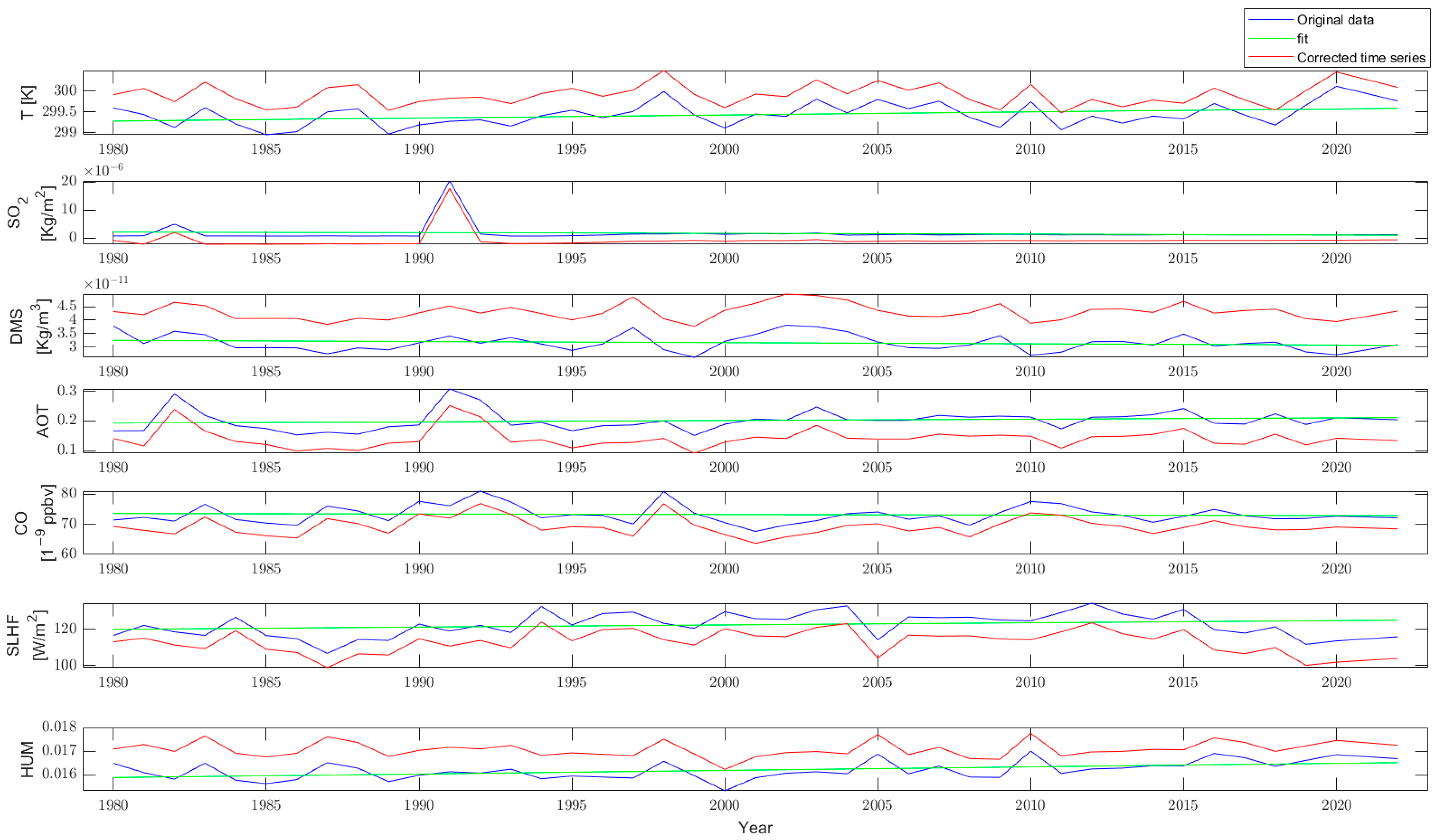
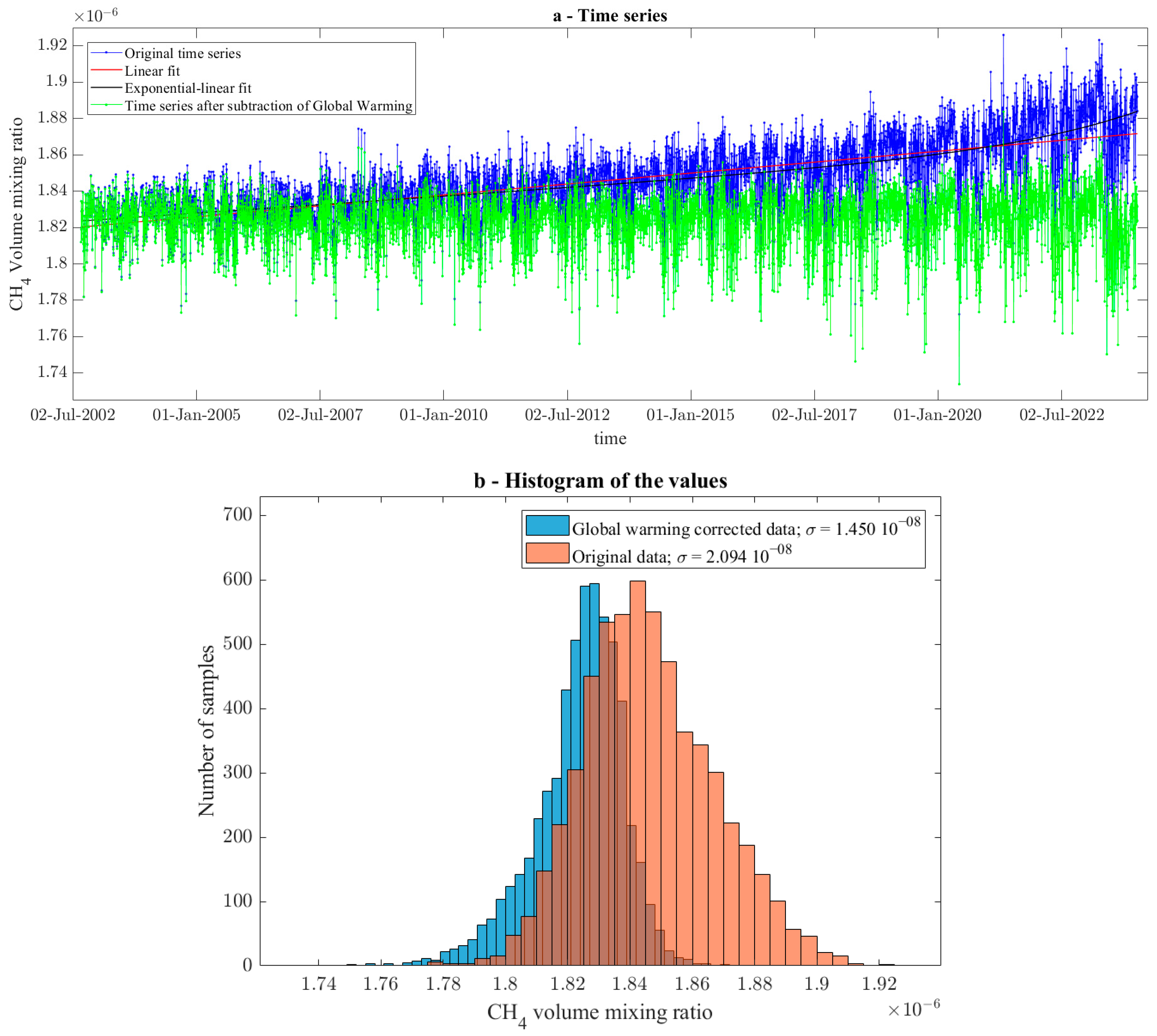
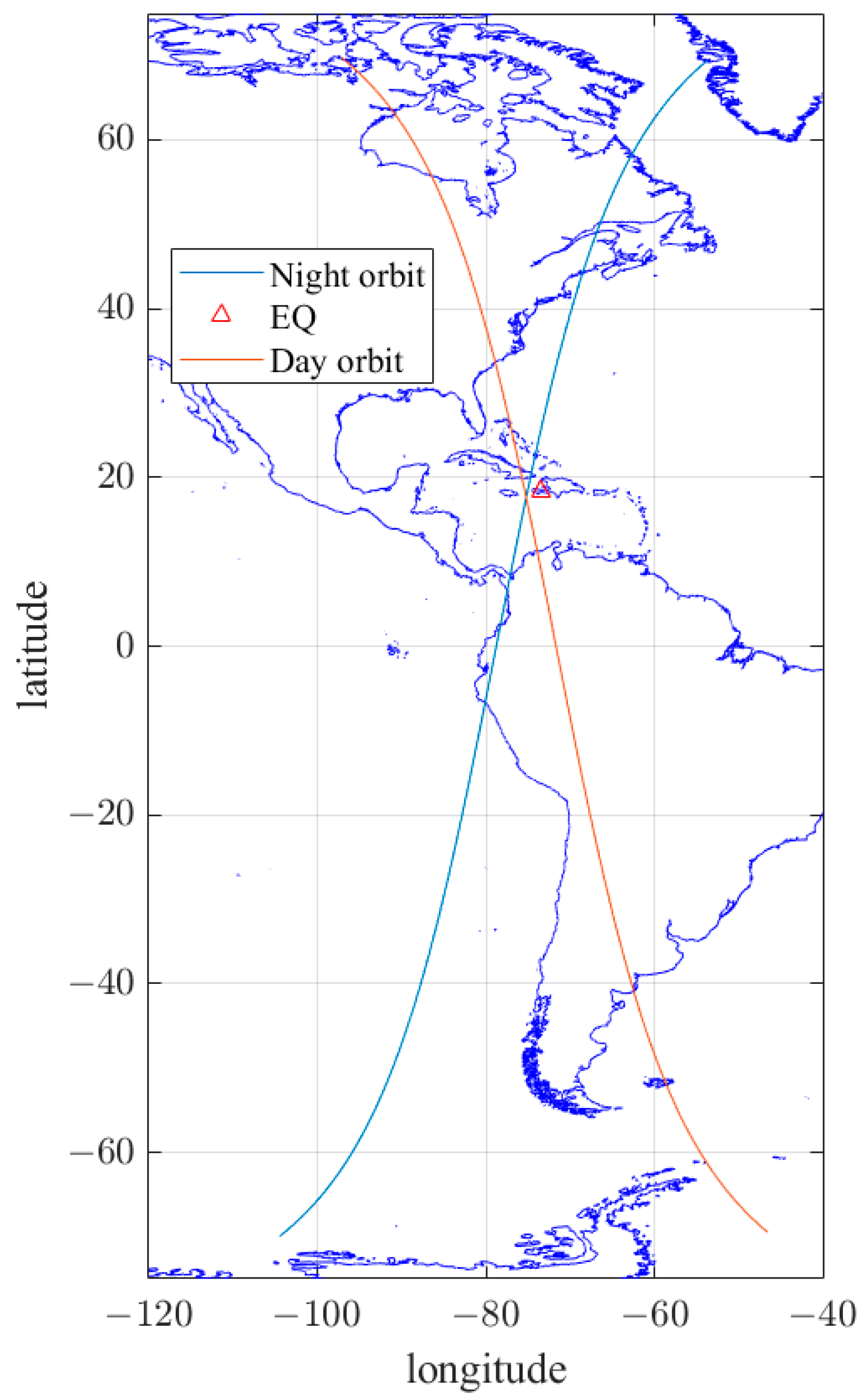
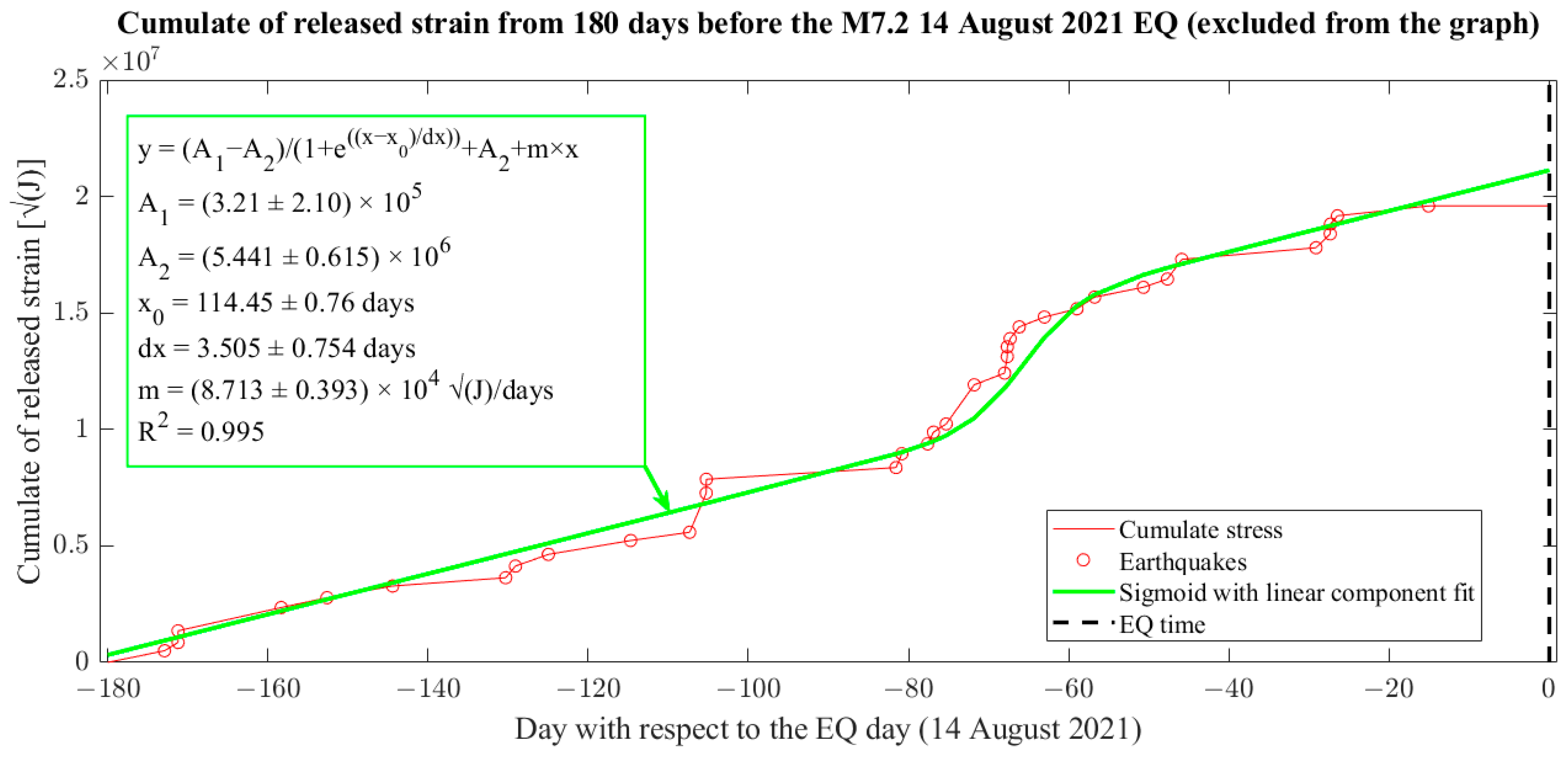
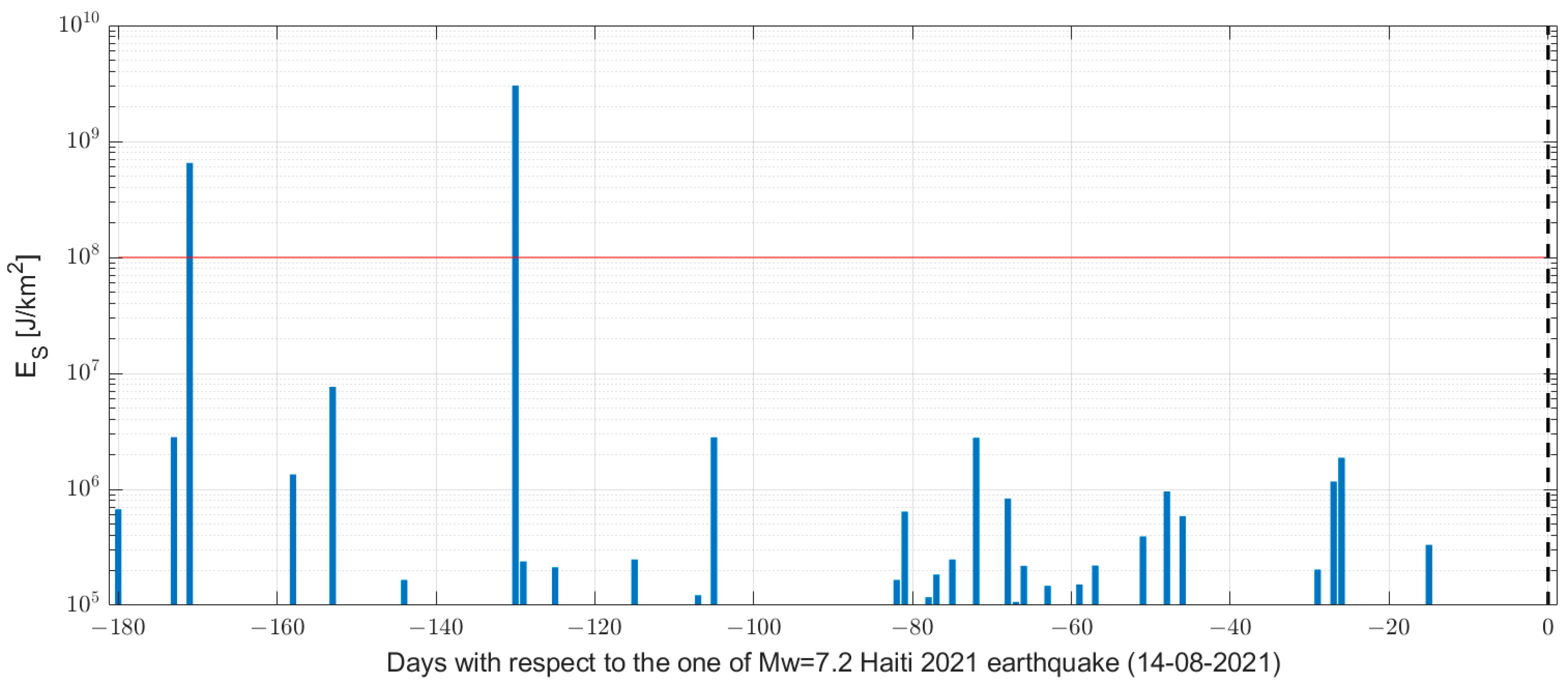
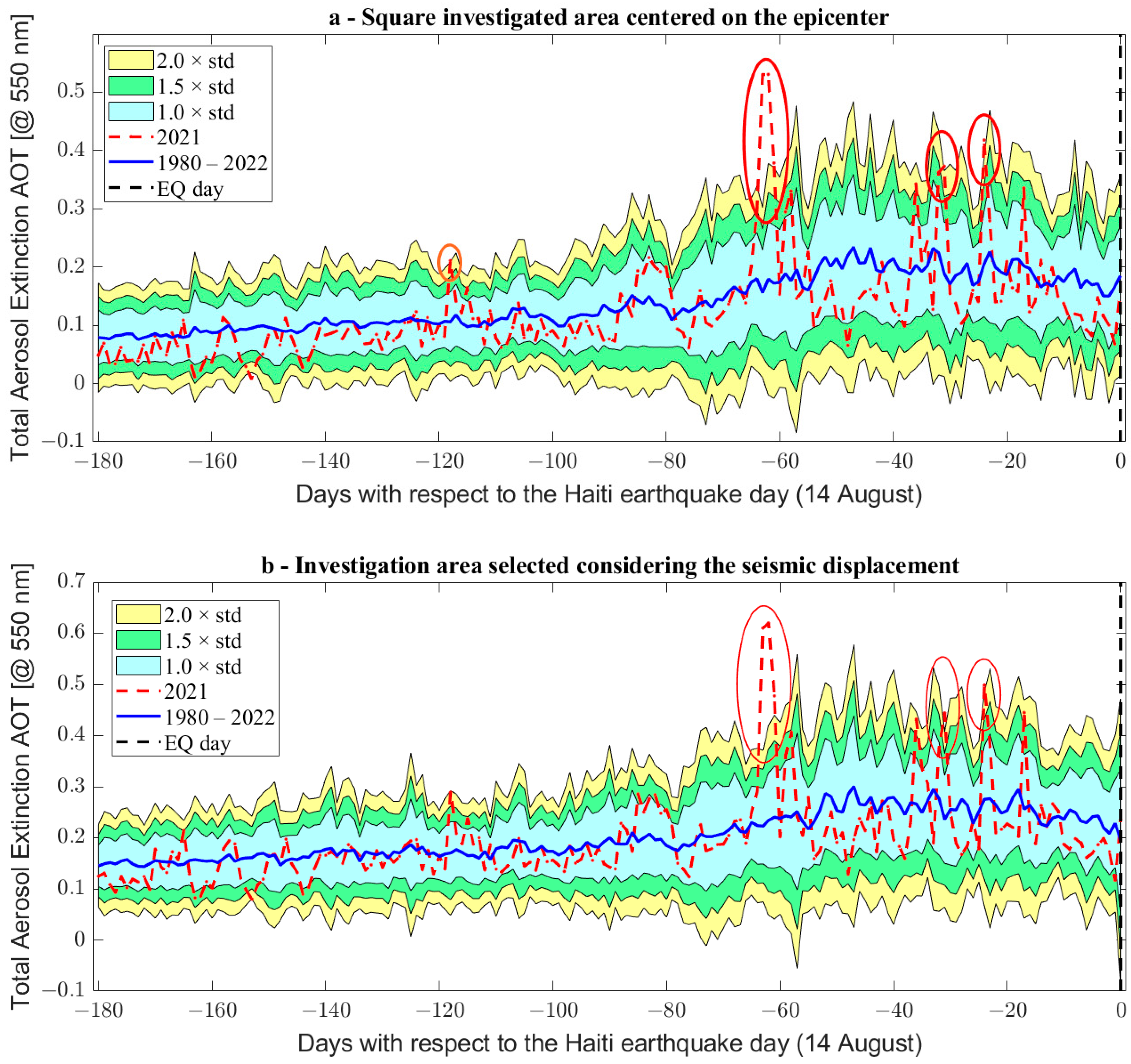
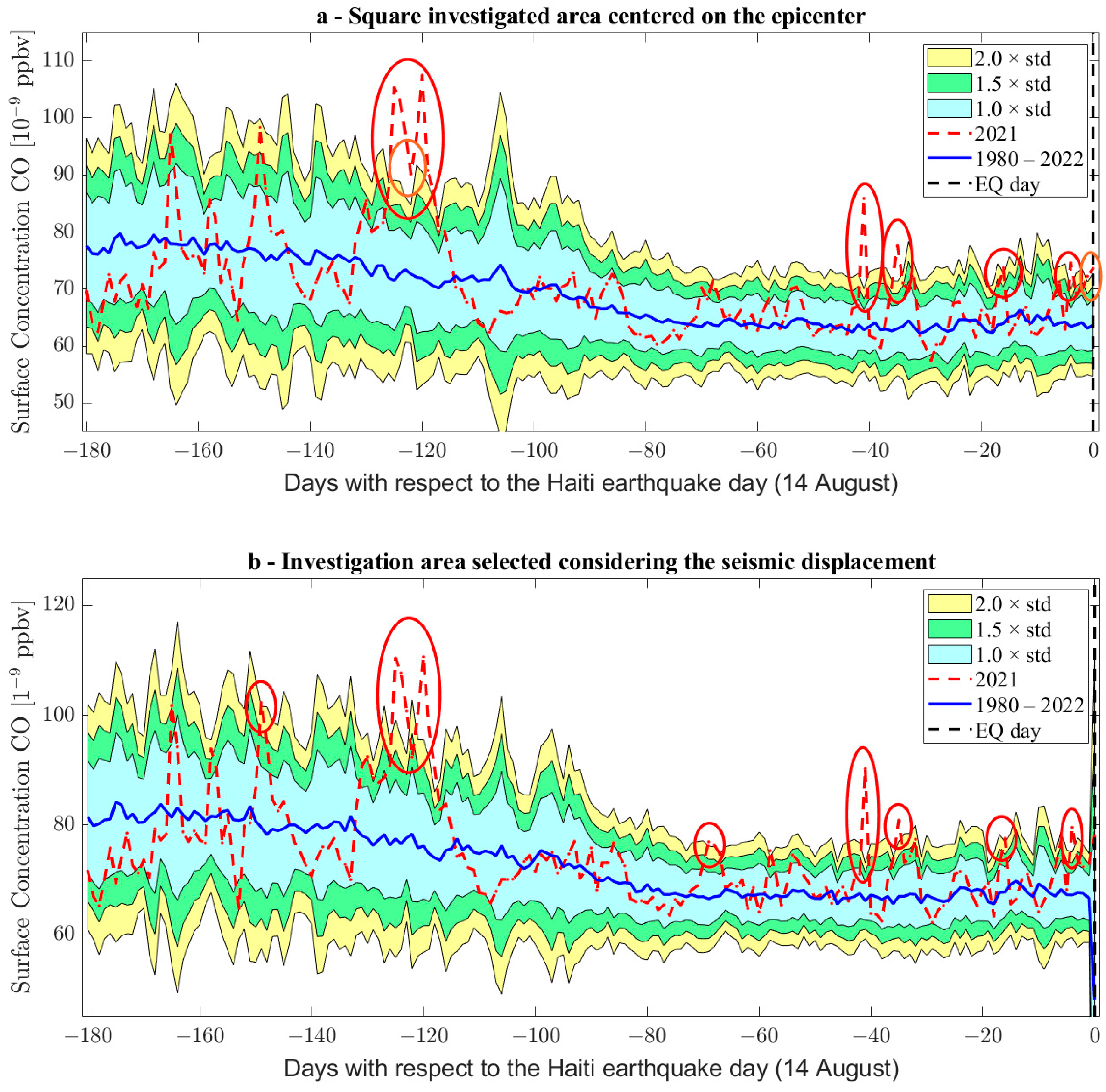
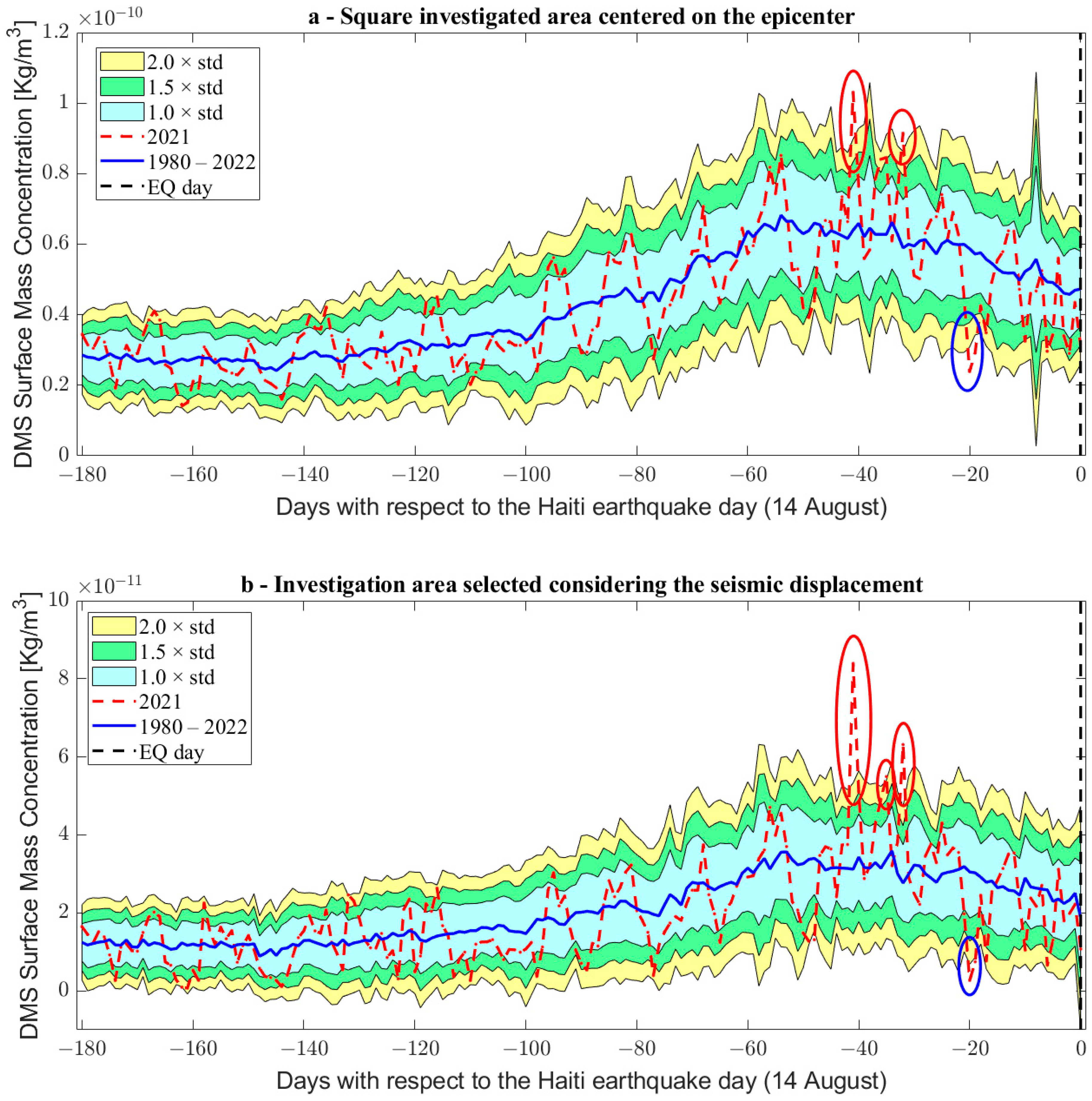

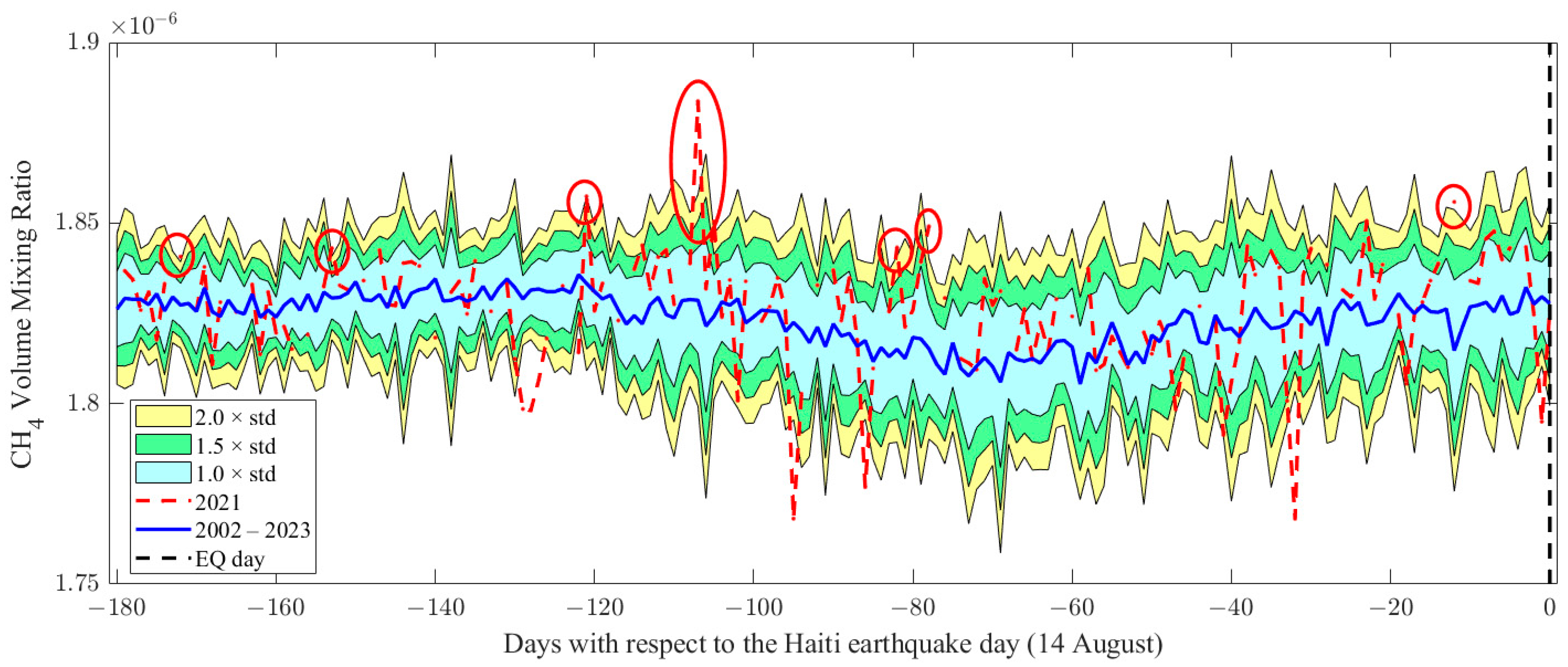
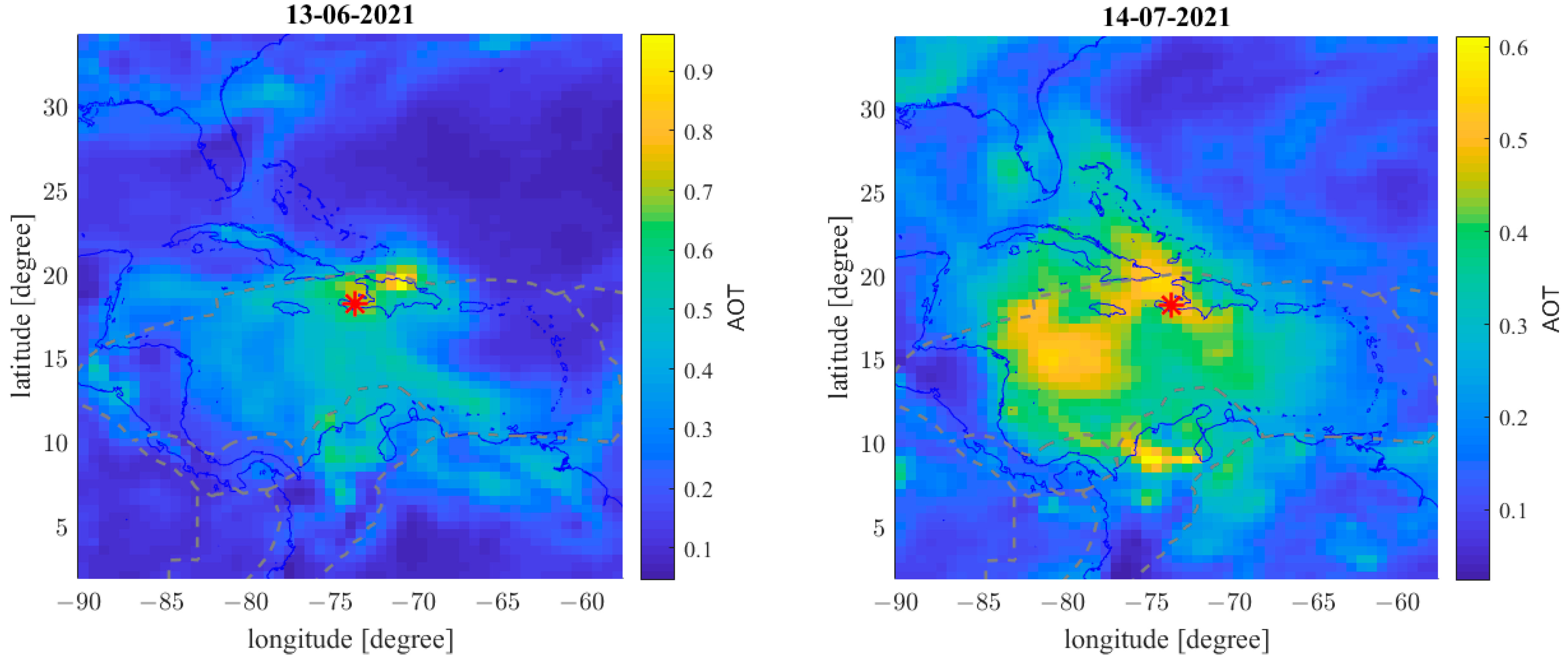

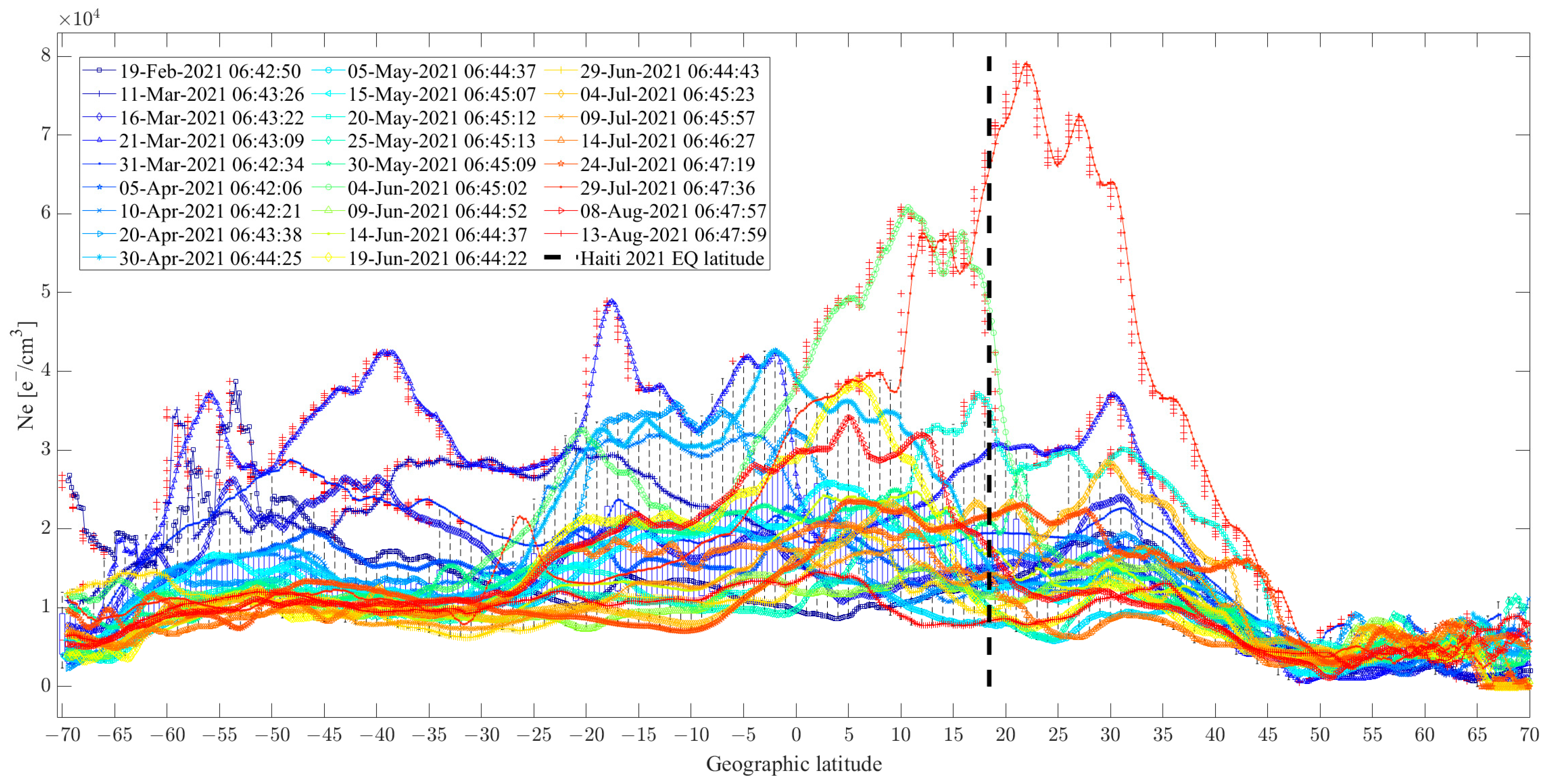
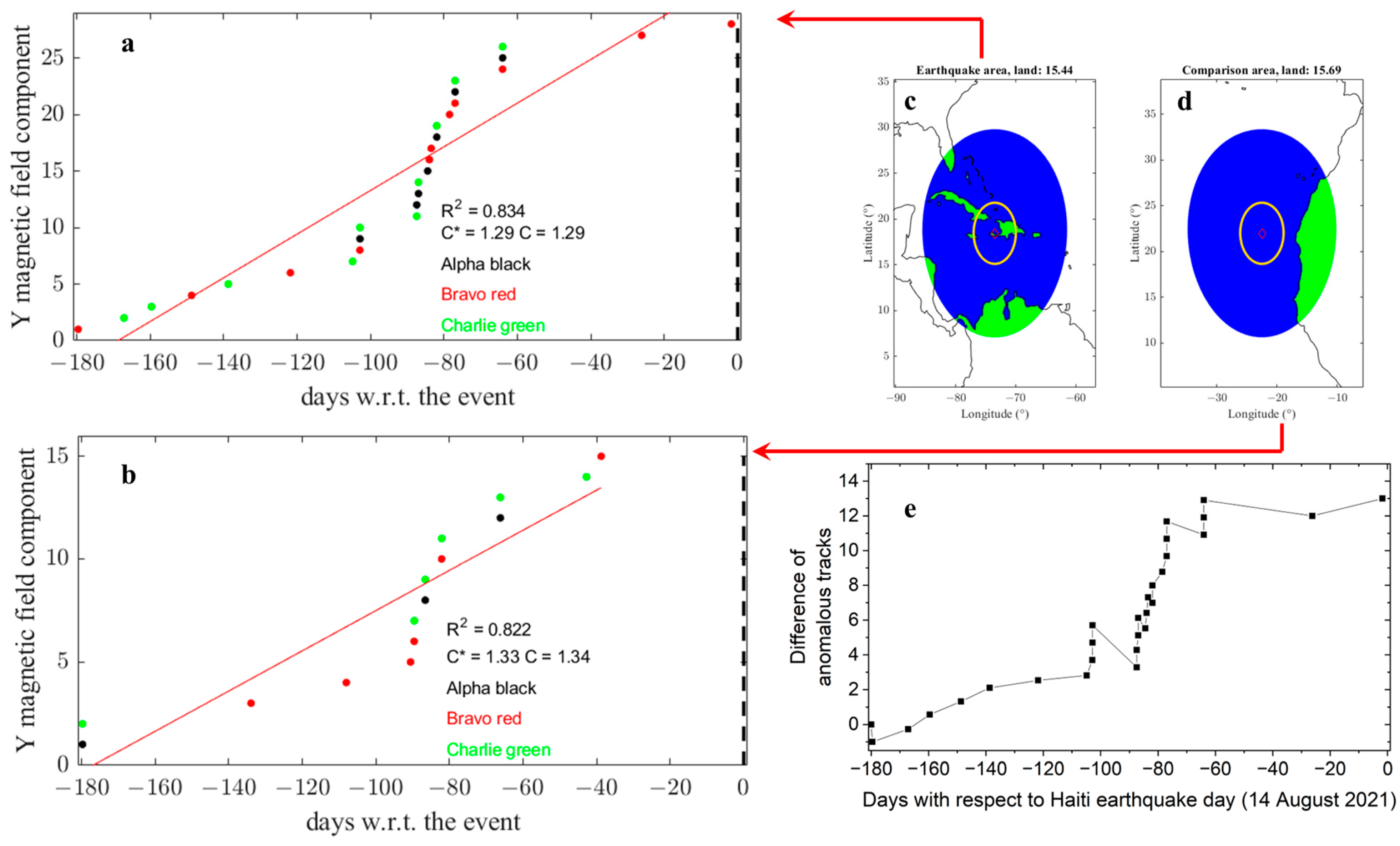
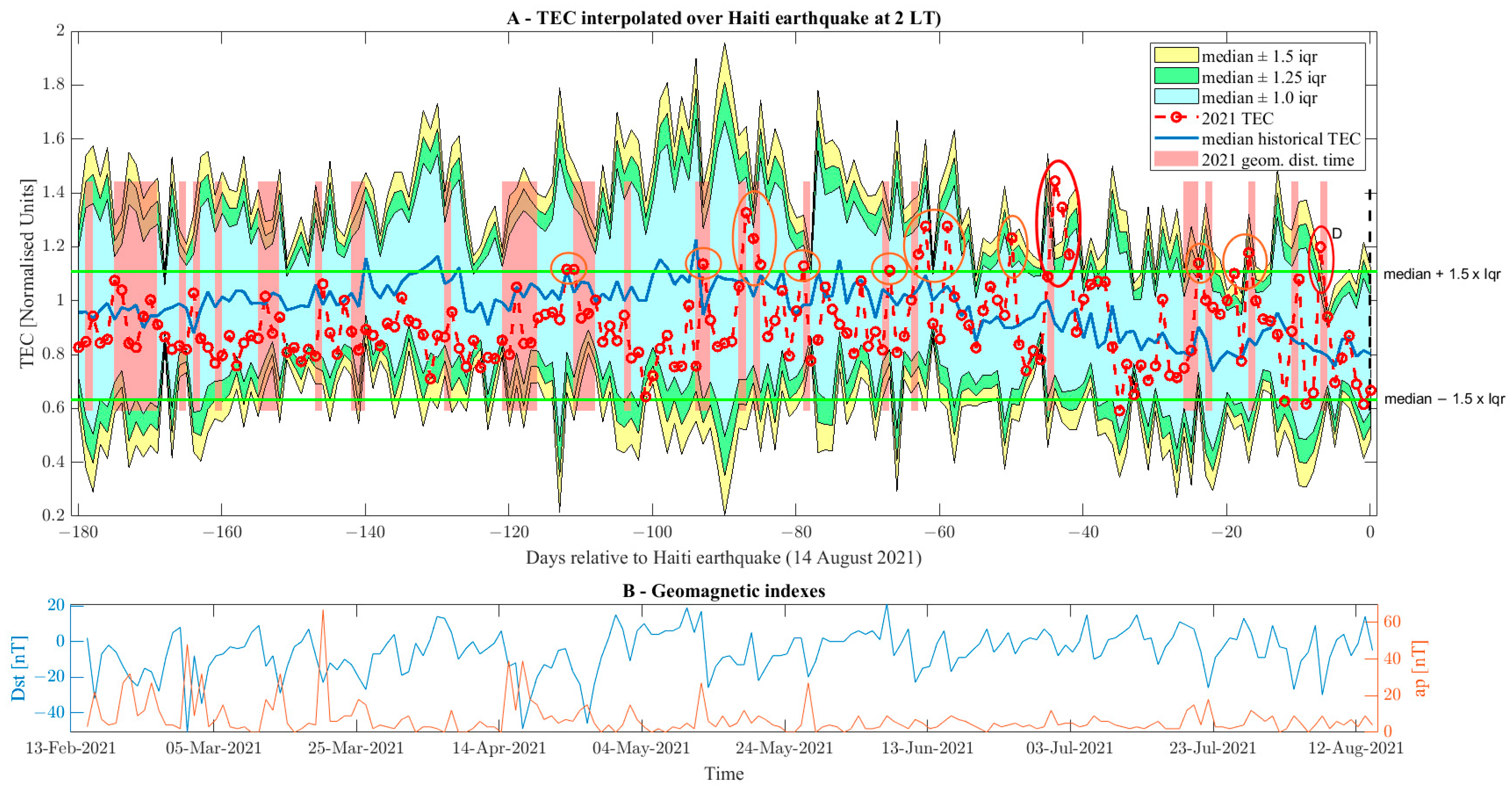

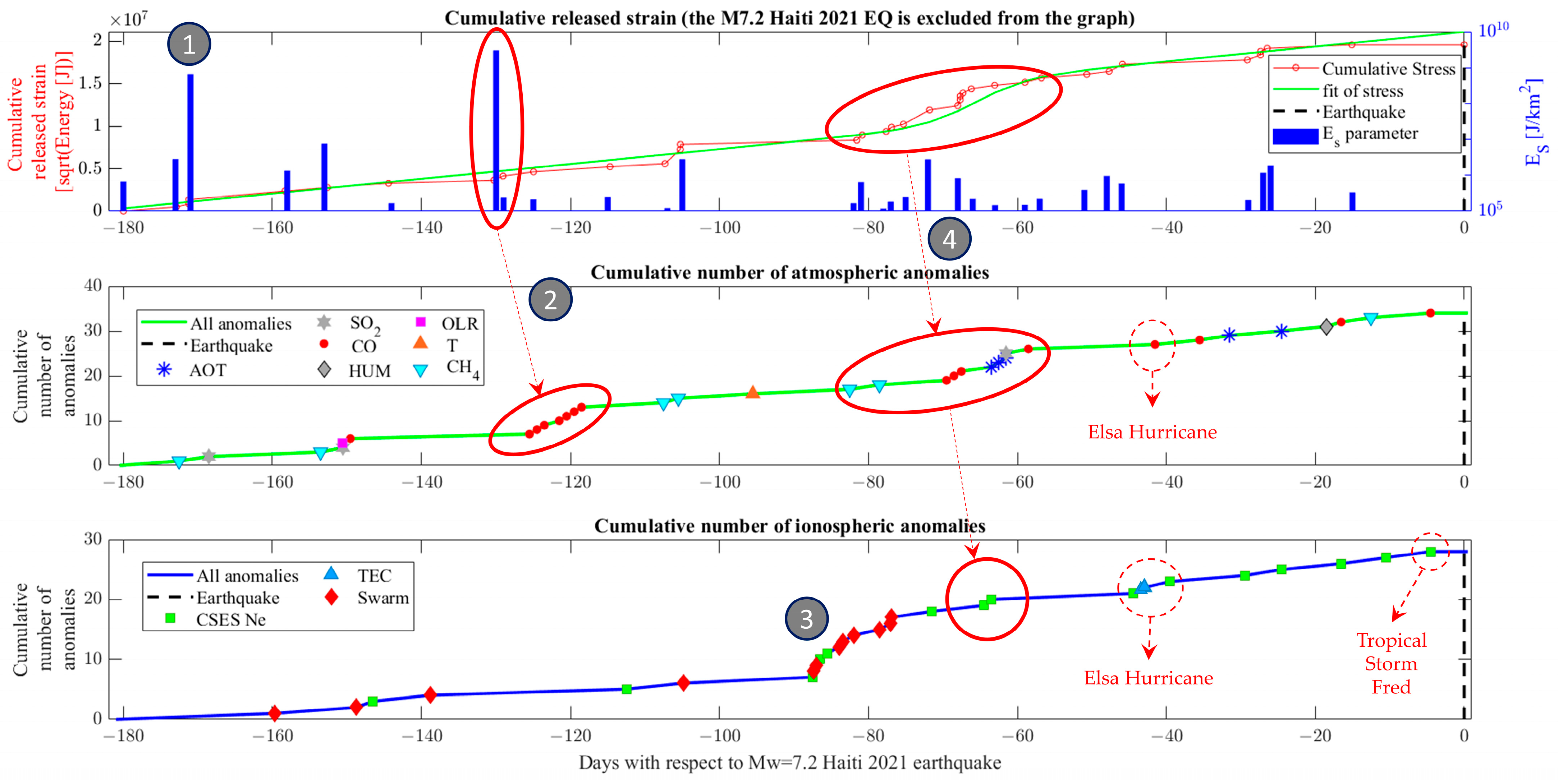
| Parameter | Anomalous Day [2021] | Anticipation Time [Day] | Value |
|---|---|---|---|
| Lithosphere | |||
| ES | 24 February | −171 | 6.5 × 108 J/km2 |
| 6 April | −130 | 3.0 × 109 J/km2 | |
| Atmosphere | |||
| Aerosol | 12 June | −63 | 0.61 |
| 13 June | −62 | 0.62 | |
| 14 June | −61 | 0.48 | |
| 14 July | −31 | 0.44 | |
| 21 July | −24 | 0.50 | |
| SO2 | 27 February | −168 | 1.93 × 10−6 kg/m2 |
| 17 March | −150 | 1.86 × 10−6 kg/m2 | |
| 14 June | −61 | 2.29 × 10−6 kg/m2 | |
| CO | 18 March | −149 | 102 × 10−9 ppbv |
| From 11 to 18 April (excluding 14 April) | From −125 to −118 (excluded −122) | 97 ÷ 111 × 10−9 ppbv | |
| From 6 to 8 June | From −69 to −67 | 75 ÷ 77 × 10−9 ppbv | |
| 17 June | −58 | 75 × 10−9 ppbv | |
| 4 July 1 | −41 | 90 × 10−9 ppbv | |
| 10 July | −35 | 81 × 10−9 ppbv | |
| 29 July | −16 | 78 × 10−9 ppbv | |
| 10 August | −4 | 80 × 10−9 ppbv | |
| Humidity | 27 July | −18 | 0.0164 |
| OLR | 17 March | −150 | 187 W/m2 |
| Temperature | 11 May | −95 | 301 K |
| CH4 | 24 February | −171 | 2.24 σ |
| 15 April | −153 | 2.40 σ | |
| 17 April | −107 | 3.76 σ | |
| 1 May | −105 | 2.29 σ | |
| 14 May | −82 | 2.18 σ | |
| 28 May | −78 | 2.71 σ | |
| 7 July | −12 | 2.11 σ | |
| Ionosphere | |||
| CSES-01 Ne | 20 March | −147 | 1.232 × 104 e−/cm3 |
| 23 April | −113 | 1.737 × 104 e−/cm3 | |
| 18–20 May | From −88 to −86 | (1.006 ÷ 3.019) × 104 e−/cm3 | |
| 3 June | −72 | 2.704 × 104 e−/cm3 | |
| 10–11 June | −65 | 2.7 × 104 e−/cm3 | |
| 30 June | −45 | 3.398 × 104 e−/cm3 | |
| 5 July | −40 | 2.065 × 104 e−/cm3 | |
| 15 July | −30 | 1.309 × 104 e−/cm3 | |
| 20 July | −25 | 3.288 × 104 e−/cm3 | |
| 28 July | −17 | 4.076 × 104 e−/cm3 | |
| 3 August | −11 | 1.246 × 104 e−/cm3 | |
| 9 August | −5 | 1.155 × 104 e−/cm3 | |
| TEC | 1 July | −44 | 1.44 TECU 2 |
| 2 July | −43 | 1.35 TECU 2 | |
Disclaimer/Publisher’s Note: The statements, opinions and data contained in all publications are solely those of the individual author(s) and contributor(s) and not of MDPI and/or the editor(s). MDPI and/or the editor(s) disclaim responsibility for any injury to people or property resulting from any ideas, methods, instructions or products referred to in the content. |
© 2024 by the author. Licensee MDPI, Basel, Switzerland. This article is an open access article distributed under the terms and conditions of the Creative Commons Attribution (CC BY) license (https://creativecommons.org/licenses/by/4.0/).
Share and Cite
Marchetti, D. Observation of the Preparation Phase Associated with Mw = 7.2 Haiti Earthquake on 14 August 2021 from a Geophysical Data Point of View. Geosciences 2024, 14, 96. https://doi.org/10.3390/geosciences14040096
Marchetti D. Observation of the Preparation Phase Associated with Mw = 7.2 Haiti Earthquake on 14 August 2021 from a Geophysical Data Point of View. Geosciences. 2024; 14(4):96. https://doi.org/10.3390/geosciences14040096
Chicago/Turabian StyleMarchetti, Dedalo. 2024. "Observation of the Preparation Phase Associated with Mw = 7.2 Haiti Earthquake on 14 August 2021 from a Geophysical Data Point of View" Geosciences 14, no. 4: 96. https://doi.org/10.3390/geosciences14040096






